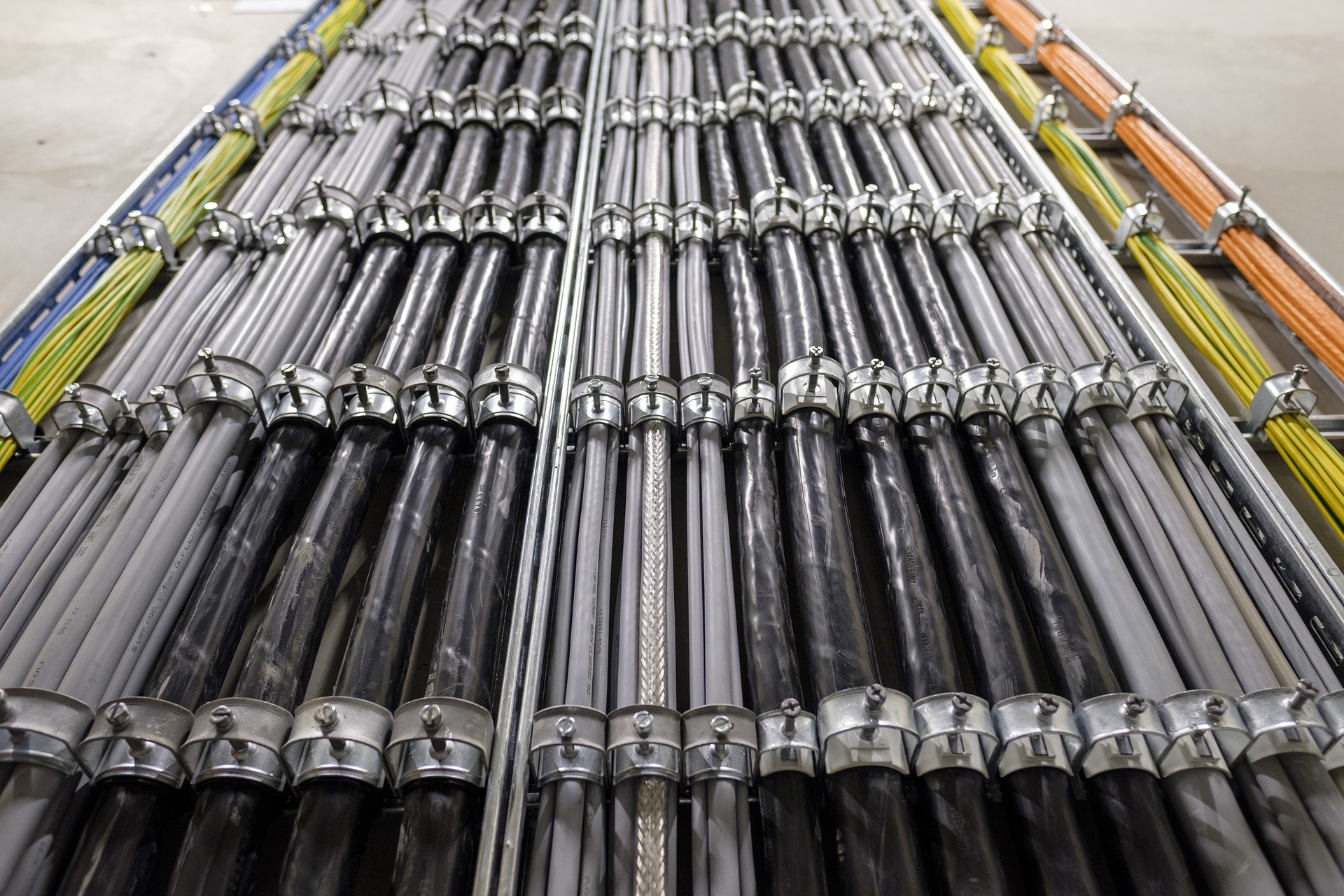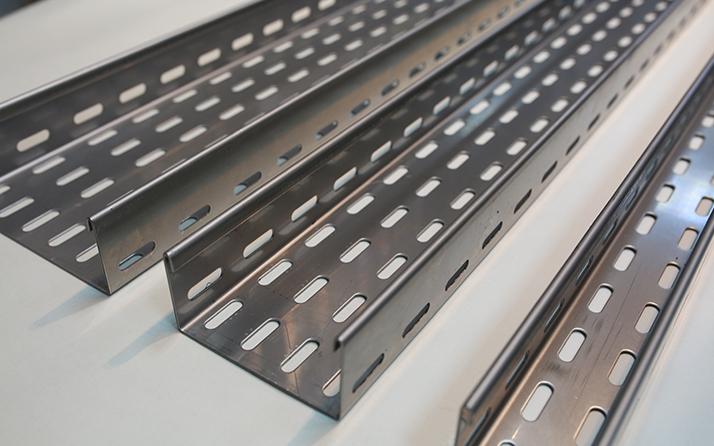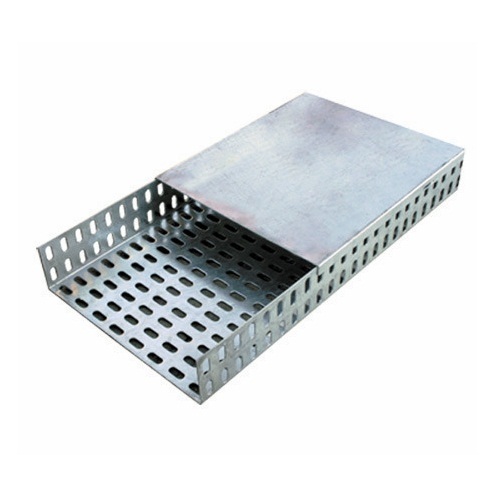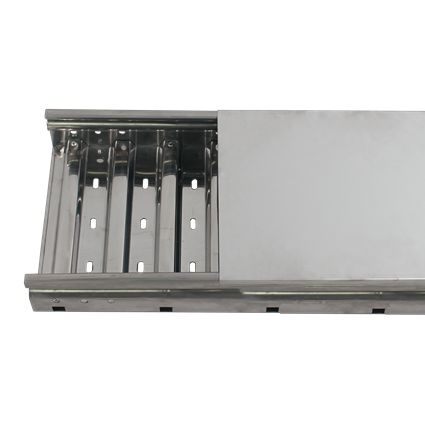A simple guide of how cable trays and ladders work
There are many major manufacturers and suppliers of
Cable Trays near Dubai, UAE. The Cable Tray System is made according to the British/European standard BS EN 61537 and the American standard NEMA VE-1. Cable trays are offered in a variety of depths, material thicknesses, and widths to accommodate the different needs of cable installations, from telecommunications to power distribution. For each kind of tray, a comprehensive selection of appropriate, factory-made fittings is available, giving options for both vertical and horizontal directional adjustments. Typically, main cable trays & ladders are fabricated from carbon steel and then hot-dipped galvanized in accordance with international standard BS EN ISO 1461 to provide corrosion protection; however, a variety of alternative materials and finishes are also available to accommodate a wide range of installation conditions.

What are cable trays?
Cable trays near Dubai are a form of
construction material used to secure courses, cables, and wires inside a structure. These cable trays enable installers to route these wires inside a shaped path, as opposed to allowing them to continue traveling over the roof and walls without protection. The trays can handle security wires, and data transfers, in addition to any other types of electric cables required inside the building. While specific orders may vary, the vast majority of national and regional building standards mandate the use of cable trays of varying sizes.
As technology advances, so does the need for competent safety procedures. This has given Cable Tray Manufacturers in the UAE a boost, and they have since developed a variety of cable trays.
Cable trays are fabricated from continuously cold-formed steel sections for lightweight construction, which are then hot-dipped and hardened after shape. It can be constructed of fiberglass-reinforced plastic (FRP), aluminum, or steel. The range of plates includes light, medium, and heavy-duty
ladder cable trays for metal-encased cables. Perforated, heavy-duty cable trays provide constant support for non-metallic-encased cables. The reach is fully functional for managing a variety of phone wires, signal cables, power cables, and multi-conductor control cables.
The primary purpose of the cable tray is to reliably secure the cables and wires inside. These trays keep wires organized and make it simpler for maintenance personnel to manage and locate wiring-related components. The cable tray allows you to follow a wire to its proper location to do maintenance. Keeping these wires in place decreases the risk of electric shock for circuit testers and installers. Choosing which material to use will depend on what the local building codes say. A financial strategy may also play a role in such a decision.
Which form of cable trays near Dubai are used in industrial settings?
1. Perforated cable trays
Perforated Cable Trays are constructed from a single piece with either a perforated or solid bottom. Primarily used with power cables and control cables. They come in light, medium, and heavy-duty depending on what the client wants and the conditions of the site.
2. Ladder Cable Tray
Ladder-type cable tray consists of two longitudinal side channels connected by individual traverse channels and offers solid rail protection and system strength with smooth radius fittings and a wide variety of materials/finishes.
3. Basket Cable Tray
Basket cable trays are deemed essential for routing and sustaining several cable lines. The wired framework improves airflow and cable ventilation. This is suitable for placement under workstations, raised floors, or suspended tray systems. You can build basket trays for corners, horizontal portions, mounting bracing,
hardware, and tray cutters.
4. Raceways - Cable Tray Trunking
Raceway and cable tray trunking are commonly used to set up
cables and wires underground. A raceway is available with single or multiple columns enabling the simultaneous installation of several cable connections. The products are widely used in the telecommunications,
hardware electronics, and electrical industries, among others.
What is a Ladder Cable Tray?

Uses and Its Benefits
The purpose of cable ladder systems and cable tray systems is to support cables, not to provide complete mechanical protection. They are not meant to be used as ladders, walkways, or supports for humans, since doing so may result in bodily harm and cause damage to the system and any associated wires.
Cable ladders in the UAE consist of two longitudinal side members joined by individual transverse members and are intended for use as a support system for power or control cables. Cable Ladders and vented trays can be equipped with solid coverings to shield wires from falling debris, dust, and moisture. Tray covers that are used outside or in dusty places can have a peaked shape so that dust, ice, or snow can fall off. In cases where a large number of tiny cables are needed, such as for telephone or computer network connections, lighter cable trays are preferable. These trays can be formed of wire mesh and referred to as "cable baskets," or they can be structured as a single central spine (rail) with ribs on each side to hold the cable.
A cable ladder system is used in the electrical wiring of buildings to support insulated electrical wires used for power distribution, control, and communication.
To prevent wires from overheating, large power cables installed in the tray need support blocks to maintain distance between conductors. Smaller cables can be arranged loosely in horizontal trays or fastened with cable ties at the bottom of vertical trays.
To maintain cable support when a tray's elevation or orientation changes, a vast variety of specialized cable tray fittings are designed to be compatible with each type and manufacturer. Horizontal elbows alter the orientation of a tray in the same plane as the tray's bottom and are available in 30, 45, and 90-degree configurations; inside and outside elbows are used for modifications perpendicular to the tray's bottom. These can take numerous forms, such as tees and crosses. Some manufacturers and kinds include movable elbows, which can be used to fit a tray around obstructions or odd forms on-site.
A cable ladder system consists of a variety of straight lengths and variable-shaped connectors intended to permit changing cabling directions or levels without requiring component modification. Ladders are usually thought to be the strongest products available to support cables because they can hold a lot of weight over a long time. This is why project managers often ask for them to be installed on sites, where distributing a lot of cables quickly, safely, and reliably is the most important thing.
What's the difference between a cable ladder & cable tray?
Cable ladder :

- Has a straightforward design with side rails with connecting rungs. The perforated rungs make it simple to attach cable ties and cable cleats directly to the ladder
- It is of a stronger build. Easy configuration
- It is of sturdy construction
- Since airflow is free, there is no need to reduce the amount of current that a cable can carry
- Fewer accessories are needed
- Can carry a significant load
- Cable ladders are used in non-public places such as industrial buildings and basements
- Appropriate for electrical, cables and wires instrumentation, and telecom cables
- Supports heavy wires, cable bundles, and pipelines over extended distances
- Cables can enter and leave the span at any point
- Ladders provide unrestricted airflow, which is necessary to prevent wires from overheating
- The minimal buildup of moisture, dust, or liquid
- Cables are freely accessible, which facilitates inspection and future adjustments
- Covers can also be used to shield cables from UV radiation, precipitation, and vandalism distances
Cable tray :

- Cable trays are aesthetically pleasing and used in public spaces
- Cable trays are available in various hues to complement the building's exterior
- Cable Tray near Dubai consists of a single metal sheet. Numerous cable trays have slots, making it simple to place equipment and secure cable ties and other fasteners
- Appropriate for use with light-weight electrical and instrumentation cables and tubing
- The bottom protection lowers electromagnetic interference, while the holes allow for water drainage and ventilation
- Trays give extra support and prevent wires from sagging, which might degrade the functionality of the circuit
- The most visually pleasant alternative is cable trays. In buildings without ceiling panels, cable trays are a wonderful solution for concealing and organizing wires
- Covers can be added to shield cables from UV rays, snow/ice, and vandalism
Both are cable enclosures. But there is a difference
What are Cable Tray Covers
Cable tray manufacturers in the UAE provide an extensive selection of cable tray covers to shield the system's cables from sunlight, external factors, dirt, debris, and falling things. All of the coverings featured here are suitable for both indoor and outdoor usage. The covers are made from corrosion-resistant aluminum, mill-galvanized steel, galvanized steel, and 304 or 316 stainless steel. Although HDGAF steel coverings are not recommended, they are available upon request (some distortion may occur when dipping). The majority of coverings are offered in conventional 12-foot lengths and are available upon request in five- or six-foot lengths. Covers for HDGAF are available in lengths of five or six feet, and 18 GA material is needed.
1. Flat and Flat Flanged
Flat coverings are available for all straight sections and fittings and are inexpensive. For the Husky Trough, Husky Ladder, and Husky Way, these coverings are offered flat with or without 3/8" flanges. If you need a cover for a 4" or 6" wide channel, you should use a flat-flanged cover.
2. Hat-Shaped
Covers in the form of a hat are intended to safeguard installations in which the cables protrude over the top flanges of the tray. There are hat-shaped coverings available with either a flat, solid top or a corrugated, vented top and in either 2" or 4" height.
3. Louvered
For all straight portions, louvered coverings are provided as Flat, Flat Flanged, and Hat Shaped.
4. Peaked
Only available for straight stretches, peaked coverings are often used to deflect falling items or prevent snow and another debris buildup. The standard peak height is 0.5 inches; however, peaks of a higher elevation are available upon request.
5. Corrugated
Ventilated or non-ventilated corrugated sheets are used to construct corrugated coverings. Except for the Husky Ladder Flange-Out type, corrugated coverings are strong, lightweight, and easily formable to vertical fittings. All horizontal fitting covers consist of non-ventilated (solid) flat sheets devoid of a flange.
Cable tray manufacturers in the UAE
There are a number of prominent manufacturers and providers of cable trays and ladders used to support insulated electric wires in various sectors. Different finishes, materials, and designs of cable trays are available on the UAE market. Many industrial and commercial applications find them to be very valuable. Because they provide maximal cable flexibility, they are very useful for installations. The cable tray supplier in UAE sells these of superior quality with industrial applications, such as stack ability, collapsibility, and versatility. Cable trays and ladders have rungs that optimize cable bearing surface and can be used with rung slots used for cable wrapping to assist support weights.
Cable tray manufacturers in the UAE have served the industry for many years and have played a significant part in the growth of the UAE economy. The manufacturers have the most up-to-date machinery and equipment, which are handled by engineers who are skilled in their respective fields, to create cable trays that satisfy the customers' expectations and earn their confidence. They adhere to international standards to assure the quality of their goods. In addition to the extensive variety of cable tray suppliers in the UAE, cable trays are also available with a broad variety of accessories and fittings of various sizes,
metals, and profiles.



